Summary The Mara veterinary unit was involved in a number of activities during the month of March, these included treatments of an adult male elephant with a spear wound on the right side of the abdomen in Siana conservancy
Summary
The Mara veterinary unit was involved in a number of activities during the month of March, these included treatments of an adult male elephant with a spear wound on the right side of the abdomen in Siana conservancy. Another elephant was treated in Naiboshio conservancy and Ngama hills in Masai Mara. All the veterinary activities went on successfully during the month as reported below.
Treatment of a wounded male elephant in Siana conservancy in Masai Mara.
This was a case of an adult male elephant which had an infected wound on the right lateral side of the abdomen in Siana conservancy within the Mara ecosystem. The wound was much infected with a lot of necrotic debris and pus oozing out from the opening. The elephant was sighted by the scouts and manager of Siana conservancy who immediately informed the vet to attend to it. The elephant was under a great pain and preferred resting under tree most of the time. It also had the risk of developing peritonitis and septiceamia that could easily lead to death.
Chemical immobilization, examination and treatment
The elephant was darted from a vehicle using 17mgs of etorphine Hcl combined with 3000 i.u on the right thigh. The drug took effect after about 5 minutes and it went down. The wound was then examined for the presence of any foreign object, it was then pressed and cut open to drain all the pus and necrotic debris completely. The wound was further probed using long tissue forceps and hands wrapped in long-sleeved gloves. It was a deep wound extending into the pelvic cavity and it had a metallic spear (2 feet long) lodged inside.
The spear was retrieved by hand. Further inspection revealed no traumatic injury to vital internal organs and the elephant had better chances of recovery after the removal of the spear-head. The wound was further cleaned with a lot of water and gauze swabs removing all the accumulated pus, necrotic tissues and loose tissue debris. It was then cleaned and debrided using 10% hydrogen peroxide draining all the accumulated pus and necrotic tissue debris, then treated using a tincture of iodine followed by oxytetracycline spray. It was also covered with green clay powder which maintains wound cleanliness, repel flies and enhance pus drainage. The wound was left open to enhance drainage of pus. Further treatments by intramuscular administration of long-acting Amoxycillin (Betamox) antibiotics and flunixin meglumine were provided.
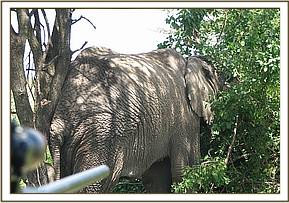
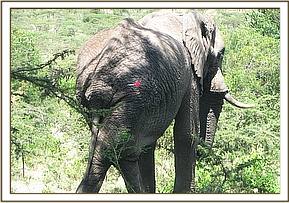
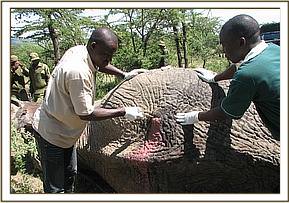
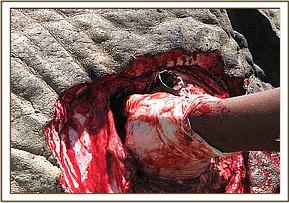
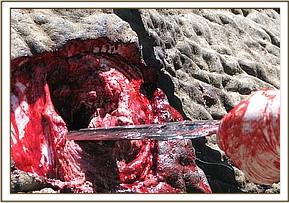
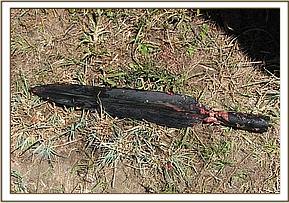
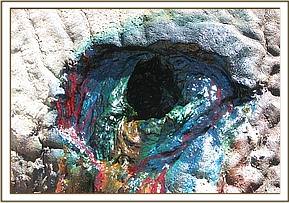

Revival of anaesthesia
After treatment, the elephant was revived from anaesthesia using 48mgs of diprenorphine hydrochloride administered through the superficial ear-vein. It was to be monitored closely by the scouts and management of Siana conservancy who would report the progress to the vet in case the elephant required further attention.
Prognosis
The elephant had good chances of recovery after the removal of the spear-head and no internal organ injury was detected. However, the elephant was to be monitored daily by the scouts of the conservancy and report to the vet just in case the elephant required further treatment. It was also planned to be treated again after 10 days to enhance quick recovery. Unfortunately it was later attacked by unknown criminals and killed by gun shots on the head.
Treatment of a wounded male elephant in Naiboshio conservancy in Masai Mara.
This was a case of an adult male elephant which had traumatic wounds on the right side of the shoulder and on the proximal part of the trunk in Naiboshio conservancy within the Mara ecosystem. It had several other small injuries over the back, abdomen and on the legs whose cause was not known. The elephant was sighted by the scouts and manager of Naiboshio conservancy who immediately informed the vet for intervention. It was under pain and preferred resting under trees and near watering points most of the time. Chemical immobilization, examination and treatment
The elephant was darted from a vehicle using 17mgs of etorphine Hcl combined with 2500 i.u on the left thigh. The drug took effect after about 6 minutes and it became recumbent. The wounds were then examined pressed and cut open to drain all the pus and necrotic debris completely. The wounds were then cleaned with a lot of water and gauze swabs removing all the pus and necrotic tissues.
They were further cleaned and debrided using 10% hydrogen peroxide draining all the accumulated pus and necrotic tissue debris, then treated using a topical application of tincture of iodine, Opticlox eye ointment and oxytetracycline spray. The wounds were also covered with green clay powder which maintains wound cleanliness, repel flies and enhance pus drainage. One of the large wounds on the shoulder region was sutured using Chromic cat-gut 2.0 to avoid contamination and developing ascending infection. Further treatments by intramuscular administration of long-acting Amoxycillin (Betamox) antibiotics and flunixin meglumine were provided.
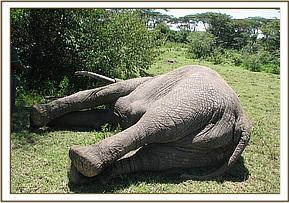
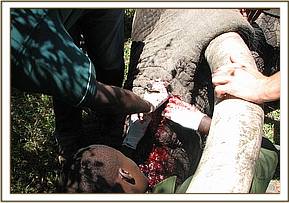

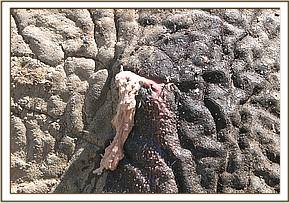
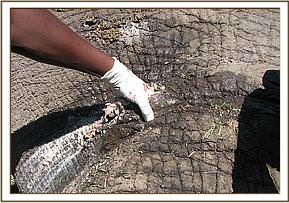
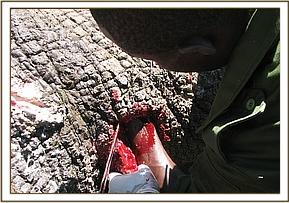
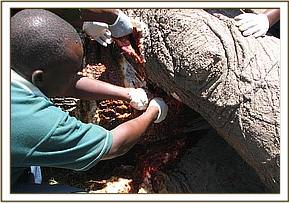
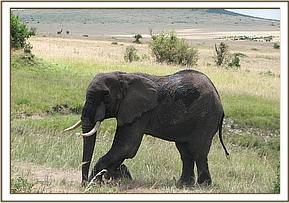
After treatment, the elephant was revived from anaesthesia using 60mgs of diprenorphine hydrochloride administered through the superficial ear-vein. It was monitored closely by the scouts and management of Naiboshio conservancy who later reported that the elephant recovered from the injury.
Treatment of a wounded male elephant in Ngama hills in Masai Mara NR.
This was a case of an adult male elephant which had an infected wound on the right lateral side of the abdomen in Masai Mara National Reserve close to Ngama hills. The wound was much infected with a lot of necrotic debris and pus oozing out from the opening. The accumulated pus resulted into a swelling of the right abdomen due to lack of an opening for drainage. The cause of the injury was not known but it was suspected that the animal could have been shot by an arrow-head or a spear. The elephant was sighted by the rangers and wardens of Masai Mara who immediately informed the vet to attend to it. It was under severe pain and preferred resting near water pool most of the time. It also had the risk of developing peritonitis and septiceamia that could easily lead to death. Chemical immobilization, examination and treatment
The elephant was darted from a vehicle using 16mgs of etorphine Hcl combined with 2500 i.u on the right thigh. The drug took effect after about 6 minutes and it became recumbent. The wound was then examined for the presence of any foreign material but there was none, it was then pressed and cut open to drain all the pus and necrotic debris completely. The wound was later cleaned with a lot of water and gauze swabs removing all the pus and loose necrotic tissue debris. It was also probed using long tissue forceps in an attempt to find out how deep it penetrated into the tissues.
It was also cleaned and debrided using 10% hydrogen peroxide draining all the accumulated pus and necrotic tissue debris, then treated using a topical application of a tincture of iodine, Opticlox eye ointment and oxytetracycline spray. It was also covered with green clay powder which maintains wound cleanliness, repel flies and enhance pus drainage. Further treatments by intramuscular administration of long-acting oxytetracycline and flunixin meglumine were provided.
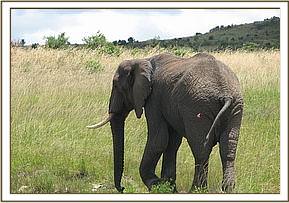
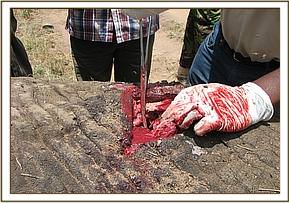
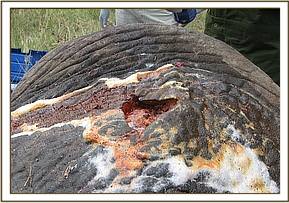
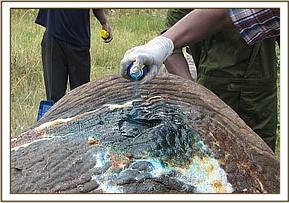


Revival of anaesthesia
After treatment, the elephant was revived from anaesthesia using 48mgs of diprenorphine hydrochloride administered through the superficial ear-vein.
Prognosis
It had poor prognosis as it was suspected to have been shot by a poisonous arrow or spear leading to generalized muscular paralysis and weakness. It was to be monitored closely by the rangers of Masai Mara National reserve who would report the progress to the vet in case the elephant required further attention.
Acknowledgements
Kenya Wildlife Service (KWS) appreciates the continous support of the David Sheldrick Wildlife Trust towards provision of wildlife veterinary services in Masai Mara ecosystem this has significantly contributed to the general wildlife health and conservation in the Mara ecosystem. We also acknowledge the support of KWS rangers and staff from Masai Mara National Reserve, Naiboshio conservancy, Siana Conservancy and the surrounding community-owned wildlife conservancies for continuous support and reporting of wildlife incidences requiring veterinary intervention in the Mara ecosystem.
Report by: Dr. Domnic Mijele